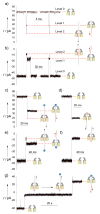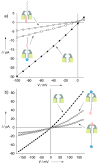Single DNA rotaxanes of a transmembrane pore protein
- PMID: 15188482
- PMCID: PMC1866269
- DOI: 10.1002/anie.200453907
Single DNA rotaxanes of a transmembrane pore protein
Abstract
Supramolecular chemistry at the single-molecule level. An α-hemolysin transmembrane pore can be threaded in a desired orientation by DNA-PEG hybrid strands to yield functional rotaxanes. The single-molecule rotaxanes display stable and reversible two-state switching capacity depending on the applied potential, orientation, and the method of threading and capture used.
Figures





References
-
- Kasianowicz JJ, Brandin E, Branton D, Deamer DW. Proc Natl Acad Sci USA. 1996;93:13770. - PMC - PubMed
- Akeson M, Branton D, Kasianowicz JJ, Brandin E, Deamer DW. Biophys J. 1999;77:3227. - PMC - PubMed
- Vercoutere W, Winters-Hilt S, Olsen H, Deamer D, Haussler D, Akeson M. Nat Biotechnol. 2001;19:248. - PubMed
- Howorka S, Cheley S, Bayley H. Nat Biotechnol. 2001;19:636. - PubMed
-
- Song L, Hobaugh MR, Shustak C, Cheley S, Bayley H, Gouaux JE. Science. 1996;274:1859. - PubMed
-
- Korchev YE, Bashford CL, Alder GM, Kasianowicz JJ, Pasternak CA. J Membrane Biol. 1995;147:233. - PubMed
- Bezrukov SM, Vodyanov I, Brutyan RA, Kasianowicz JJ. Macromolecules. 1996;29:8517.
- Howorka S, Movileanu L, Lu X, Magnon M, Cheley S, Braha O, Bayley H. J Am Chem Soc. 2000;122:2411.
Publication types
MeSH terms
Substances
Grants and funding
LinkOut - more resources
Full Text Sources
Other Literature Sources

